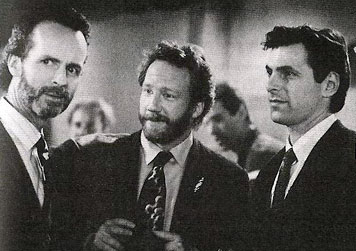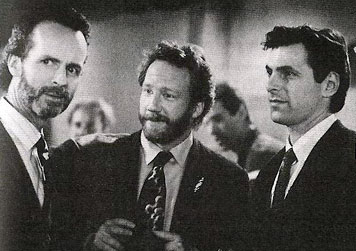
July 11, 2008
I Was A Mad Man

thirtysomething, c.1989. Miles Drentell (David C Lennon) with Elliot Weston (Timothy Busfield) and Michael Steadman (Ken Olin)
In the winter of 1976, while still a student, I worked lunches at a Greek restaurant on Madison Avenue in New York City. Three or four days a week, a well-dressed gentleman in his 50s would come to lunch — strangely alone — and sit at the bar and order a martini. (And ultimately two more, but never three.) He managed to read the Wall Street Journal and eat a little lunch. I was his waiter and his bartender.
Art was the head account guy in an important advertising agency down the street — some job just below the president, a creative guy named Milt Gossett. I asked Art why he wasn’t out at client lunches, and he said he preferred to eat alone — that he’d done hundreds if not thousands of lunches in his time. “It’s time for others to hold down the fort,” he’d bellow. (Art was deaf in one ear.) After a few months, Art started asking me what I was going to do when I graduated from college that spring. He pushed the idea of business school at me, and said he could get me into Dartmouth. I kept saying no, that I didn’t want an MBA. Eventually, I was persuaded to let him introduce me to “some people.” Ten interviews later, over the course of only a few weeks, I had job offers from Time, HBO, Warner Bros., and, the most unlikely place, Compton Advertising.
Mad Men takes place in 1960. Just seventeen years later, I went to work at a place a lot like Sterling Cooper, “an old-school agency … run on smooth presentations, fastidious account handling, and, actually, three-martini lunches,” (described in Michael Bierut’s recent post). At the age of twenty-four, without an MBA, I became an assistant account executive at Compton Advertising. My charge: the Ivory Liquid account.
***
Jump forward to 1988. Another decade has passed, and with it, a new view of advertising, thanks to the extraordinary reach of television. It is difficult to describe the degree to which a little show called thirtysomething had seized the American public: at its core, an ensemble cast in which two characters run a small but influential ad agency in Philadelphia. I get a call from a college friend, Ed Zwick, the co-creator of thirtysomething, asking me to come out to L.A. for a couple of days: “Just talk to us about your agency.” Never mind that Drenttel Doyle Partners was a design firm, or that I’d long since walked away from a successful career on Madison Avenue: in Hollywood, these are small differences. A first class ticket is sent to me, and I spend a comfortable couple of days on a couch in Santa Monica, telling stories of what would happen if my “agency” went out of business. At the end of the season, The Michael and Elliot Company goes backrupt, and Michael and Elliot end up agonizing over the liability of their million dollar 10-year lease, how to divide the CD collection, and ultimately, who would get the god-damn coffee maker — all details we discussed on that couch in West LA. A little weird, but fun: my Mom was proud.
***
When I started at Compton, account executives on Procter & Gamble generally had MBAs from Penn, Columbia or Dartmouth. We were white and generally male. We bought our (white) shirts at one of three places: Brooks Brothers, J.Press (“of New Haven”), or Paul Stuart. There were no other acceptable choices. I remember one black person, a messenger. I remember firing a female account executive who was not quite cutting it, and my peers giving me a wink over drinks.
My future wife, an aspiring writer before she discovered design, worked at the same agency in the early 80s — on the 4th floor while I was on 7. Her primary job, beyond getting coffee, was to protect her boss from his wife finding out about his mistress and his afternoon trysts. Twenty years after Mad Men, the culture hadn’t really changed that much. (And I wouldn’t meet Jessica Helfand for another decade.)
***
In 1979, with about 18-months experience, I went to Italy to launch Pampers. Since Italy was considered the third world in those days, I went overnight from being an assistant account executive to being a managing director. I rented a penthouse in the Teatro di Marcello, and spent three lovely years living in Rome. My tenure began with a weekly trip to Milan; quickly escalated to a week in Zurich every quarter for film production; and then, with the advent of international brands, to monthly European coordination meetings in London, Frankfurt, Amsterdam or Paris. In 1982, Compton merged with Saatchi & Saatchi, and I returned to New York — not yet 30 and a senior vice president — to a very different agency. Within two years, about 80% of the account management staff (in an agency known for its stability and long-term up-or-out employment ) would be gone. Maurice Saatchi (and his finance wizard, Martin Sorrell, later of Sir Martin of WPP fame) would unleash a storm in the advertising world that would destroy the gentlemanly facade once and for all: his newest prize, Compton Advertising (and its network across 30 countries) would be the initial casualty of his imperial reign. If the era of Mad Men had a death date, it was effectively 1982.
***
And yes: the pitch was everything. I used to fly into two or three cities a week and give presentations which I only received an hour before at the airport. I’d be handed a reel and a dozen boards, an account executive or two, and together — with at least one “creative” in tow — our mission was to go sell whatever was in the bag. It turned out I was pretty good at this. Over time, I got a reputation for being able to sell anything. We won cellular telephones from AT&T and watched the first cell tower being built in the suburbs of Chicago. (We subsequently watched AT&T get divested by court order, whereupon I spent a year on the road pitching the seven new regional Bells — and winning three of them.) Meanwhile, I never forgot my Procter & Gamble roots, running Comet Cleanser, which later involved the most expensive commercial we’d ever shoot — with dancing ladies looking at clean sinks, and then, feet still tapping, smilingly at a side-by-side stain comparison. I swear it was perfectly natural, the dancing and the clean sinks — or so I thought at the time.
***
There is one pitch I especially remember. One day, sometime in the early 1980s, I was called into the president’s office for a “boy’s” meeting, and asked: how’s your game? I had never done an especially good job of faking an interest in sports among the boys over the urinal (the scene YET to happen in Mad Men), so I didn’t have the foggiest notion that he meant golf — yet days later, I’m on the fairway with the CEO of a Southern fast food chain shooting at least 50 over par.
It was the only time I’d played golf and, not surprisingly, I was never asked again. But I did win the Krystal Restaurants account — at the time, the first fast food account we’d ever won.
Some months later I go to Chattanooga for the first presentation of our new national advertising campaign. It was a family-owned business started by Rody Davenport Jr. in 1932. I’m meeting with the next-generation Davenport in the biggest building in Chattanooga, on the top floor, at a huge conference table that seats at least forty. I get out my black bag: I do my pitch. He lets everyone in the room speak. Things are going well.
Then the CEO turns to me, ignoring everyone else, and asks me to take out my wallet. He asks me how much money I have. I count about $150, and tell him so. He smiles, looks me squarely in the eye, and asks: “Would you spend your last $150 on this shit?”
The rest of the story involves me telling him to take out his own wallet and me swearing I’d spend not only my money but all of his. And we did. We spent all of Krystal’s money, millions of dollars. We made second-rate advertising, and they had second-rate stores with really second-rate hamburgers. We deserved each other.
***
Cut to 1984. I’m managing the Krystal Restaurants business and they want us not only to create their national television advertising — they want us to fix their stores. There are 27 different store designs, every one with a different signage configuration. The problem is daunting, and I bring in two “real” designers to help — Stephen Doyle and Tibor Kalman.
There’s a big meeting: the two of them on one side of the table and a lot of high-priced art directors and creative directors on our side. We show them slides of Krystal signage. Tibor is speechless, perhaps the only time in his life. Stephen, at some point, says: “I don’t understand the problem. You take good pictures of hamburgers and then you crop the hell out of them.” The meeting ends.
And that’s what we did. We took good pictures of hamburgers and then cropped the hell out of them.
***
I did meet one designer at Compton. I barely remember his name, but I knew he was different. I was used to watching creative directors choose type by pointing in big books and saying, “Let’s make it look something like this.” There were, hard as it is to imagine, no computers in the studio — the bullpen, as it was called. And these were art directors groomed in an era where television advertising was all that mattered. But down on the fourth floor we had a small team working on IBM collateral. Not real money, so no one paid them any attention. Once in a crunch, someone said: “Why don’t you get Peter down on Four to help you?” I got him to work on all of my accounts after that — there was just a different way of thinking evident in everything he touched. Not that I understood yet, but I knew.
***
About the same time, we won a small telecommunications account from a guy named Steve Case — about four businesses (and failures) before he started AOL. No one at the agency thought it was real. But then we won another account, an early iteration of MTV. We started making commercials secretly, overnight, with second-tier music talent. An unknown Madonna was an early feature, meekly coming the office for an audition. No one could process these new accounts as real accounts, but a year later the commercials for these “whacko” enterprises were leading the agency reel. Even in the mid-1980s, no one saw the revolution coming in entertainment and technology. The money was still in packaged goods, cars, fast food, liquor and cigarettes — still the age of Mad Men, twenty years after Don Draper was envisioning the Kodak Carousel.
***
It took me a decade on Madison Avenue to realize that I didn’t want to be a Mad Man, despite the thrill of the kill, the pitches, the travel. I actually came to hate advertising. I think branding is generally a plague on the earth. I’m so glad to be a designer, hardly sin-free, but closer to making things where I can say they are what they are, and not something delivered to me in a black bag in some airport. My Mad Man story is really about a person being saved by design. In 1985, I quit my job at Saatchi to start Drenttel Doyle Partners, a design firm with Stephen Doyle.
***
In 1989, the second thirtyomething season opens with a bang. I return home one evening, having missed the episode, to an answering machine full of messages from long-lost friends. Seems there is a new character, Miles Drentell (note the spelling error), the new boss of Michael and Elliot at their new place of employment. He wears expensive suits, strokes a zen sandbox, and speaks in a terrifyingly snide, controlled monotone; yet two seasons later he would commit date rape. Back in real life, every meeting I went to during those years was haunted by this character, and the question of his connection to me — the biggest asshole on television. A sweet homage by an old friend turned into a nightmare he never imagined — it being Hollywood and all, I was supposed to be honored to have my Mad Man reputation cemented on the small screen. In real life, I wasn’t.
***
I spent years ashamed by my years in advertising, and I shied away from talking about my business experience professionally because, seemingly, one cannot both be a good businessman and be a good designer. Last year, I was surprised to have my Mad Man background catch up with me. On a post on this site criticizing Rem Koolhaas for the environmental implications of his CCTV tower in Beijing, one commenter asked how my right to criticize another designer when my hands are so dirty — mentioning my tour of duty in Italy twenty-years ago filling landfills with Pampers … and all those (un)healthy meals we sold at Krystal Restaurants. Like Don Draper, whose past haunts Mad Men, our past is hardly our past.
***
I’m watching TV with my family. A particularly insipid commercial comes on, and I say, “Can you imagine being in the room where THAT idea was presented?” This is now a common refain in our family.
I was there, so I know.
Observed
View all
Observed
By William Drenttel
Related Posts

Innovation
Vicki Tan|Books
How can I design at a time like this?

Civic Life
Bert de Muynck|Essays
Walkie talkie: An architect-turned-tour guide on designing presence in Lisbon

Business
Courtney L. McCluney, PhD|Essays
Rest as reparations: reimagining how we invest in Black women entrepreneurs

Design Impact
Seher Anand|Essays
Food branding without borders: chai, culture, and the politics of packaging
Related Posts

Innovation
Vicki Tan|Books
How can I design at a time like this?

Civic Life
Bert de Muynck|Essays
Walkie talkie: An architect-turned-tour guide on designing presence in Lisbon

Business
Courtney L. McCluney, PhD|Essays
Rest as reparations: reimagining how we invest in Black women entrepreneurs

Design Impact
Seher Anand|Essays
